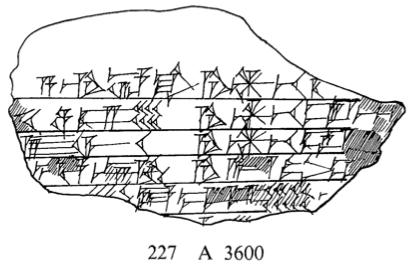Aššūr-dān III (772-755 BC), the second son of
Adad-nārārī III [http:/riao/theassyrianempire883745bc/adadnarariiii/index.html] to succeed him, is attested in only one royal inscription, a fragmentary clay cone from Ashur which refers to restoration work in the Aššur temple's main courtyard. According to the Assyrian King List [/riao/kinglists/assyriankinglist/assyriankinglist/index.html#assurnasirpal2] (AKL), he reigned for eighteen years and was succeeded by his brother
Aššur-nārārī V [http:/riao/theassyrianempire883745bc/ashurnarariv/index.html].
The Assyrian eponym chronicle [/saao/Q007771.97/], which is well-preserved for his reign, records a reign riddled with plague (years 765, 759) and revolt (years 763-759), as well as a solar eclipse [/saao/Q007771.105/], the Bur-Sagale eclipse of 763 which is so important for Near Eastern chronology. Otherwise, the Assyrian army was alternately in the land of Assyria or campaigning especially to the west and south.
Bibliography
Åkerman, K. 1998. "Aššūr-dān." In The Prosopography of the Neo-Assyrian Empire, edited by Karen Radner, 1/I:178–79. Helsinki: The Neo-Assyrian Text Corpus Project.
Baker, Heather D. 2006. "Šamšī-ilu." In Reallexikon der Assyriologie und Vorderasiatischen Archäologie, edited by Michael P. Streck, 11:639–40. Berlin: Walter de Gruyter.
Dalley, Stephanie. 2000. "Shamshi-ilu, Language and Power in the Western Assyrian Empire." In Essays on Syria in the Iron Age, edited by Guy Bunnens, 79–88. Ancient Near Eastern Studies Supplement 7. Leuven: Peeters.
Frahm, Eckart. 2017. "The Neo-Assyrian Period (ca. 1000-609 BCE)." In A Companion to Assyria, edited by Eckart Frahm, 161–208. Blackwell Companions to the Ancient World. Hoboken, NJ: John Wiley and Sons.
Fuchs, Andreas. 2008. "Der Turtān Šamšī-ilu und die große Zeit der assyrischen Großen (830-746)." Die Welt des Orients 38: 61–145.
Grayson, A. Kirk. 1982. "Assyria: Ashur-dan II to Ashur-nirari V (934-745 BC)." In The Cambridge Ancient History, Volume III, Part I: The Prehistory of the Balkans and the Middle East and Aegean World, Tenth to Eighth Centuries B.C., edited by John Boardman, I. E. S. Edwards, N. G. L. Hammond, and Edmund Sollberger, Second edition, 238–81. Cambridge: Cambridge University Press.
Grayson, A. Kirk. 1993. "Assyrian Officials and Power in the Ninth and Eighth Centuries." State Archives of Assyria Bulletin 7: 19–52.
Grayson, A. Kirk. 1996. Assyrian Rulers of the Early First Millennium BC II (858-745 BC). The Royal Inscriptions of Mesopotamia: Assyrian Periods 3. Toronto: University of Toronto Press.
Grayson, A. Kirk. 1999. "The Struggle for Power in Assyria: Challenge to Absolutive Monarchy in the Ninth and Eighth Centuries B.C." In Priests and Officials in the Ancient Near East: Papers of the Second Colloquium on the Ancient Near East - The City and Its Life Held at the Middle Eastern Culture Center in Japan (Mitaka, Tokyo) March 22-24, 1996, edited by Kazuko Watanabe, 253–70. Heidelberg: Universitätsverlag C. Winter.
Mattila, Raija. 2000. The King's Magnates: A Study of the Highest Officials of the Neo-Assyrian Empire. State Archives of Assyria Studies 11. Helsinki: The Neo-Assyrian Text Corpus Project.
Mattila, Raija. 2011. "Šamšī-ilu." In The Prosopography of the Neo-Assyrian Empire, edited by Heather D. Baker, 3/II:1226. Helsinki: The Neo-Assyrian Text Corpus Project.
Millard, Alan R. 1994. The Eponyms of the Assyrian Empire 910-612 BC. State Archives of Assyria Studies 2. Helsinki: The Neo-Assyrian Text Corpus Project.
Radner, Karen. 2006. "Provinz. C. Assyrien." In Reallexikon der Assyriologie und Vorderasiatischen Archäologie, edited by Michael P. Streck, 42–68. 11. Berlin: Walter de Gruyter.
Schramm, Wolfgang. 1973. Einleitung in die assyrischen Königsinschriften, zweiter Teil: 934-722 v. Chr. Handbuch der Orientalistik, Ergänzungsband 5. Leiden: Brill.
Zaia, Shana. 2018. "How to (Not) Be King: Negotiating the Limits of Power within the Assyrian Hierarchy." Journal of Near Eastern Studies 77: 207–17.
Browse the RIAo Corpus [http://oracc.museum.upenn.edu/riao/pager/]
1
1
This text is inscribed on a fragment of a clay cone found at Ashur. It obviously describes the
restoration work carried out by Aššur-dān III on the main courtyard of Ehursagkurkurra, the
Ashur temple at Ashur. The preserved part mostly contains the royal
epithets.
[Alexander Kudryavtsev]
Access the composite text [http://oracc.museum.upenn.edu/riao/Q006691/] of Aššur-dān III 01.
Source: Ist A 03600 (Ass 17349)
Bibliography
1984 Donbaz and Grayson, RICCA no. 227 (copy, edition)
J. Caleb Howard & Alexander Kudryavtsev, 'Aššur-dān III', The Royal Inscriptions of Assyria online (RIAo) Project, The RIAo Project, a sub-project of MOCCI, 2020 [http://oracc.museum.upenn.edu/riao/theassyrianempire883745bc/ashurdaniii/]
